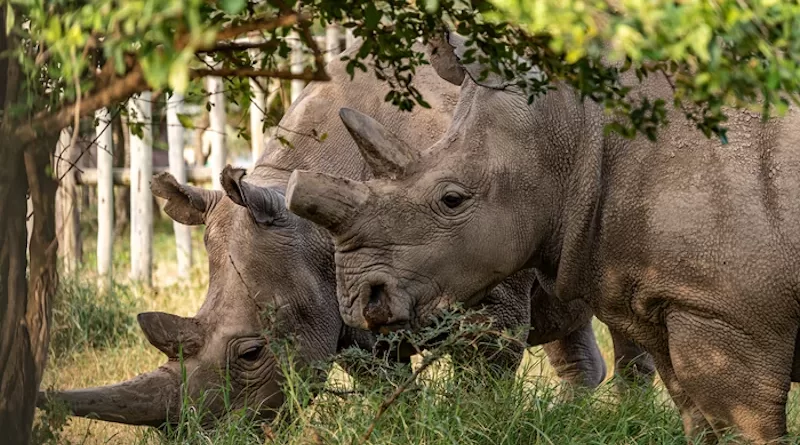BioRescue Creates Another Three Northern White Rhino Embryos, Bringing Total To 12
On July 9, the scientists and conservationists of Leibniz Institute for Zoo and Wildlife Research (Leibniz-IZW), Safari Park Dvůr Králové, Kenya Wildlife Service and Ol Pejeta Conservancy conducted the sixth successful oocyte collection at Ol Pejeta. Immediately after the oocyte retrieval, the 17 eggs – which makes it a total of 80 eggs since the procedures started in 2019 – were airlifted to Avantea laboratory in Cremona, Italy for maturation, fertilisation, embryo development and cryopreservation. Two of the embryos were produced using semen from northern white rhino bull Suni, who has provided the genetics for all the existing embryos. This time the specialists at Avantea were also able to use semen from Angalifu, a northern white rhino bull who lived in San Diego Safari Park and died in 2014. His sperm was previously thought to be incapable to successfully fertilize eggs. However, after conducting a sperm viability test using different batches of pig oocytes, the scientists were able to identify viable sperm that enabled them to create another first-grade embryo. This excellent result adds the genetics of a completely unrelated individual to the cryo-preserved population.
“Once again the use of knowledge coming from livestock species has helped to identify a batch of Angalifu semen that could eventually be used successfully to produce viable embryos,” said Prof. Cesare Galli of Avantea. “We are impressed by the number of embryos obtained from the 17 oocytes, given the paucity of eggs and the quality of the semen. It also indicates that conducting the procedure performed on a regular basis is not only harmless to Fatu but also raises the number of embryos obtained.”
In a discussion prior to the ovum pick up of July 9, the team decided not to perform an oocyte collection on Nájin, the oldest of the two northern white rhinos. Her future role in the scientific programme will be discussed in the coming weeks from an ethical perspective, and an evidence-based decision will be announced. So far, none of Nájin’s eggs have been of sufficient quality to turn into viable embryos – all 12 embryos produced so far used oocytes from Nájin’s daughter, Fatu.
“During the recent procedures it was clear that Nájin’s ovaries are no longer producing large number of eggs and that their quality is compromised,” said Jan Stejskal, Director of International Projects at Safari Park Dvůr Králové. “She is an old lady, and it seems it’s not worth subjecting her to the stress of any further procedures. However, her health status will be frequently monitored.”
In further developments on the ground in Ol Pejeta, the preparation of the embryo transfers entered a crucial phase. Two southern white rhino females were moved into the enclosure with Owuan, the sterilised southern white rhino bull who is serving as the oestrus detector for the females as they come into season. The team is carefully monitoring the welfare of all the animals and will start to observe and record their behaviour and vocalizations in preparation for the first embryo transfers which are likely to begin by the end of the year.
“We are very happy how BioRescue is progressing. The achievement of 12 embryos in total, including the first embryo from the northern white rhino bull Angalifu as well as the successful translocation of the two potential surrogates into Owuan’s enclosure demonstrate the quality of this joint project,” said Prof. Thomas B. Hildebrandt, BioRescue project leader and Head of the Department of Reproduction Management, Leibniz-IZW. “We are now focussing on the first embryo transfer in the upcoming months.”
“The welfare of all the animals involved in the project is constantly monitored both throughout the ethical risk assessment of the procedures whenever they are taking place, and the individual behavioural observations”, said Barbara de Mori, Director of the Ethics Laboratory for Veterinary Medicine, Conservation and Animal Welfare of Padua University. “A dedicated staff from both Padua University and KWS and Ol Pejeta is constantly working on data collection and is checking all the details of the daily welfare of the individual animals”.
The BioRescue research programme, significantly funded by the German Federal Ministry of Education and Research (BMBF) and additional donors such as foundation Nadace ČEZ, the philanthropist Dr. Richard McLellan, Merck and GE HeathCare, will continue with its ambitious plan to create more embryos from oocytes collected from the northern white rhino females in a three to four-month cycle as long as the COVID-19 pandemic allows for the team to travel to Kenya. With the relocation of surrogates completed, a successful embryo transfer is the next main step the BioRescue team aims at.
“It is very encouraging to note that the project has continued to make good progress in its ambitious attempts to save an iconic species from extinction. With 12 pure northern white rhinoceros’ embryos so far developed, the project should now focus on the next steps of embryos transfer into the surrogate females at Ol Pejeta Conservancy for it to achieve its ultimate objective,” said Kenya’s Tourism and Wildlife Cabinet Secretary, Hon. Najib Balala.

